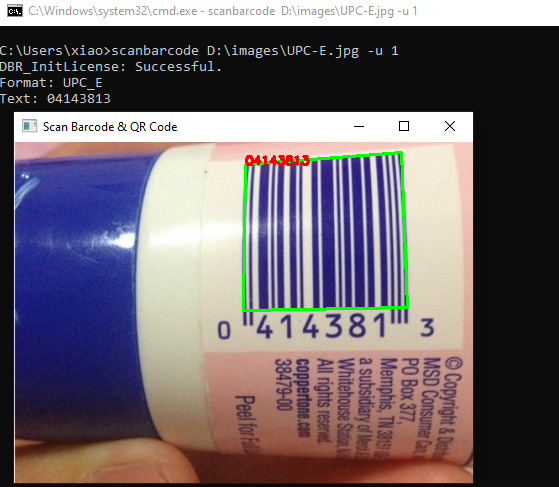The project is a CPython binding to Dynamsoft C/C++ Barcode Reader SDK. It aims to help developers build Python barcode and QR code scanning apps on Windows, Linux and macOS. Besides desktop PCs, it can work well on embedded and IoT devices such as Raspberry Pi and Jetson Nano. You are free to customize the Python API for Dynamsoft Barcode Reader.
- Dynamsoft C/C++ Barcode Reader SDK v9.4.0
- Get a 30-day FREE trial license to activate the SDK.
- Python 3.x
pip install opencv-python$ scanbarcode <file-name> -l <license-key>
# Show the image with OpenCV
$ scanbarcode <file-name> -u 1 -l <license-key>-
Create a source distribution:
python setup.py sdist
-
setuptools:
python setup_setuptools.py build python setup_setuptools.py develop # Copy libraries to barcodeQrSDK folder -
scikit-build:
python setup.py build python setup.py develop # Copy libraries to barcodeQrSDK folder -
Build wheel:
pip wheel . --verbose # Or python setup_setuptools.py bdist_wheel # Or python setup.py bdist_wheel
-
Console App
import barcodeQrSDK # set license barcodeQrSDK.initLicense("DLS2eyJoYW5kc2hha2VDb2RlIjoiMjAwMDAxLTE2NDk4Mjk3OTI2MzUiLCJvcmdhbml6YXRpb25JRCI6IjIwMDAwMSIsInNlc3Npb25QYXNzd29yZCI6IndTcGR6Vm05WDJrcEQ5YUoifQ==") reader = barcodeQrSDK.createInstance() results, elapsed_time = reader.decodeFile("test.png") for result in results: print(result.format) print(result.text) print(result.x1) print(result.y1) print(result.x2) print(result.y2) print(result.x3) print(result.y3) print(result.x4) print(result.y4)
-
Video App
import barcodeQrSDK import numpy as np import cv2 import json g_results = None def callback(results, elapsed_time): global g_results g_results = (results, elapsed_time) def run(): # set license barcodeQrSDK.initLicense("DLS2eyJoYW5kc2hha2VDb2RlIjoiMjAwMDAxLTE2NDk4Mjk3OTI2MzUiLCJvcmdhbml6YXRpb25JRCI6IjIwMDAwMSIsInNlc3Npb25QYXNzd29yZCI6IndTcGR6Vm05WDJrcEQ5YUoifQ==") # initialize barcode scanner scanner = barcodeQrSDK.createInstance() params = scanner.getParameters() # Convert string to JSON object json_obj = json.loads(params) # json_obj['ImageParameter']['ExpectedBarcodesCount'] = 999 params = json.dumps(json_obj) ret = scanner.setParameters(params) scanner.addAsyncListener(callback) cap = cv2.VideoCapture(0) while True: ret, image = cap.read() if image is not None: scanner.decodeMatAsync(image) if g_results != None: print('Elapsed time: ' + str(g_results[1]) + 'ms') cv2.putText(image, 'Elapsed time: ' + str(g_results[1]) + 'ms', (10, 30), cv2.FONT_HERSHEY_SIMPLEX, 1, (0, 0, 255), 2) for result in g_results[0]: x1 = result.x1 y1 = result.y1 x2 = result.x2 y2 = result.y2 x3 = result.x3 y3 = result.y3 x4 = result.x4 y4 = result.y4 cv2.drawContours(image, [np.int0([(x1, y1), (x2, y2), (x3, y3), (x4, y4)])], 0, (0, 255, 0), 2) cv2.putText(image, result.text, (x1, y1), cv2.FONT_HERSHEY_SIMPLEX, 1, (0, 255, 0), 2) cv2.imshow('Barcode QR Code Scanner', image) ch = cv2.waitKey(1) if ch == 27: break scanner.clearAsyncListener() if __name__ == '__main__': run()
-
barcodeQrSDK.initLicense('YOUR-LICENSE-KEY')# set barcode SDK license globallybarcodeQrSDK.initLicense("DLS2eyJoYW5kc2hha2VDb2RlIjoiMjAwMDAxLTE2NDk4Mjk3OTI2MzUiLCJvcmdhbml6YXRpb25JRCI6IjIwMDAwMSIsInNlc3Npb25QYXNzd29yZCI6IndTcGR6Vm05WDJrcEQ5YUoifQ==")
-
barcodeQrSDK.createInstance()# create a barcode reader instancereader = barcodeQrSDK.createInstance()
-
decodeFile(filename)# decode barcode and QR code from an image fileresults, elapsed_time = reader.decodeFile("test.png")
-
decodeMat(Mat image)# decode barcode and QR code from Matimage = cv2.imread("test.png") results = reader.decodeMat(image) for result in results: print(result.format) print(result.text) print(result.x1) print(result.y1) print(result.x2) print(result.y2) print(result.x3) print(result.y3) print(result.x4) print(result.y4)
-
getParameters()# return JSON stringparams = reader.getParameters()
-
setParameters(JSON string)# set barcode SDK parametersimport json json_obj = json.loads(params) json_obj['ImageParameter']['DPMCodeReadingModes'][0]['Mode'] = 'DPMCRM_GENERAL' json_obj['ImageParameter']['LocalizationModes'][0]['Mode'] = 'LM_STATISTICS_MARKS' params = json.dumps(json_obj) ret = reader.setParameters(params)
-
addAsyncListener(callback function)# start a native thread and register a Python function for receiving barcode QR code results -
decodeMatAsync(<opencv mat data>)# decode barcode QR code from OpenCV Mat asynchronouslydef callback(results, elapsed_time): print(results) import cv2 image = cv2.imread("test.png") reader.addAsyncListener(callback) reader.decodeMatAsync(image) sleep(1)
-
clearAsyncListener()# stop the native thread and clear the registered Python function -
decodeBytes(bytes, width, height, stride, imageformat)# 0: gray; 1: rgb888import cv2 image = cv2.imread("test.png") results, elapsed_time = scanner.decodeBytes(image.tobytes(), image.shape[1], image.shape[0], image.strides[0], barcodeQrSDK.ImagePixelFormat.IPF_BGR_888)
-
decodeBytesAsync# decode image byte array asynchronouslydef callback(results, elapsed_time): print(results) import cv2 image = cv2.imread("test.png") imagebytes = image.tobytes() scanner.decodeBytesAsync(image.tobytes(), image.shape[1], image.shape[0], image.strides[0], barcodeQrSDK.ImagePixelFormat.IPF_BGR_888) sleep(1)
To customize Python API based on C/C++, please refer to the online documentation.
-
Linear Barcodes (1D)
- Code 39 (including Code 39 Extended)
- Code 93
- Code 128
- Codabar
- Interleaved 2 of 5
- EAN-8
- EAN-13
- UPC-A
- UPC-E
- Industrial 2 of 5
-
2D Barcodes:
- QR Code (including Micro QR Code)
- Data Matrix
- PDF417 (including Micro PDF417)
- Aztec Code
- MaxiCode (mode 2-5)
-
Patch Code
-
GS1 Composite Code


